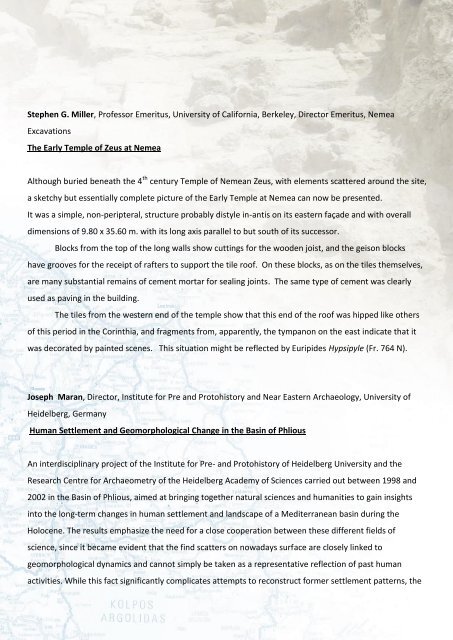ABSTRACTS - The American School of Classical Studies at Athens
ABSTRACTS - The American School of Classical Studies at Athens
ABSTRACTS - The American School of Classical Studies at Athens
Create successful ePaper yourself
Turn your PDF publications into a flip-book with our unique Google optimized e-Paper software.
Stephen G. Miller, Pr<strong>of</strong>essor Emeritus, University <strong>of</strong> California, Berkeley, Director Emeritus, Nemea<br />
Excav<strong>at</strong>ions<br />
<strong>The</strong> Early Temple <strong>of</strong> Zeus <strong>at</strong> Nemea<br />
Although buried bene<strong>at</strong>h the 4 th century Temple <strong>of</strong> Nemean Zeus, with elements sc<strong>at</strong>tered around the site,<br />
a sketchy but essentially complete picture <strong>of</strong> the Early Temple <strong>at</strong> Nemea can now be presented.<br />
It was a simple, non-peripteral, structure probably distyle in-antis on its eastern façade and with overall<br />
dimensions <strong>of</strong> 9.80 x 35.60 m. with its long axis parallel to but south <strong>of</strong> its successor.<br />
Blocks from the top <strong>of</strong> the long walls show cuttings for the wooden joist, and the geison blocks<br />
have grooves for the receipt <strong>of</strong> rafters to support the tile ro<strong>of</strong>. On these blocks, as on the tiles themselves,<br />
are many substantial remains <strong>of</strong> cement mortar for sealing joints. <strong>The</strong> same type <strong>of</strong> cement was clearly<br />
used as paving in the building.<br />
<strong>The</strong> tiles from the western end <strong>of</strong> the temple show th<strong>at</strong> this end <strong>of</strong> the ro<strong>of</strong> was hipped like others<br />
<strong>of</strong> this period in the Corinthia, and fragments from, apparently, the tympanon on the east indic<strong>at</strong>e th<strong>at</strong> it<br />
was decor<strong>at</strong>ed by painted scenes. This situ<strong>at</strong>ion might be reflected by Euripides Hypsipyle (Fr. 764 N).<br />
Joseph Μaran, Director, Institute for Pre and Protohistory and Near Eastern Archaeology, University <strong>of</strong><br />
Heidelberg, Germany<br />
Human Settlement and Geomorphological Change in the Basin <strong>of</strong> Phlious<br />
An interdisciplinary project <strong>of</strong> the Institute for Pre- and Protohistory <strong>of</strong> Heidelberg University and the<br />
Research Centre for Archaeometry <strong>of</strong> the Heidelberg Academy <strong>of</strong> Sciences carried out between 1998 and<br />
2002 in the Basin <strong>of</strong> Phlious, aimed <strong>at</strong> bringing together n<strong>at</strong>ural sciences and humanities to gain insights<br />
into the long-term changes in human settlement and landscape <strong>of</strong> a Mediterranean basin during the<br />
Holocene. <strong>The</strong> results emphasize the need for a close cooper<strong>at</strong>ion between these different fields <strong>of</strong><br />
science, since it became evident th<strong>at</strong> the find sc<strong>at</strong>ters on nowadays surface are closely linked to<br />
geomorphological dynamics and cannot simply be taken as a represent<strong>at</strong>ive reflection <strong>of</strong> past human<br />
activities. While this fact significantly complic<strong>at</strong>es <strong>at</strong>tempts to reconstruct former settlement p<strong>at</strong>terns, the

















